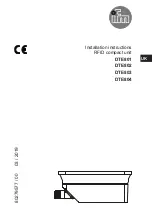
Appendix A to Section 6: 9100 System Operation — IEEE 488.2 Device Documentation Requirements
6-A1
Final Width = 215mm
Appendix A to
Section 6 of the
User’s Handbook for
Model 9100
IEEE 488.2 Device Documentation Requirements
IEEE 488.2 requires that certain information be supplied to the
user about how the device has implemented the standard. The
Device Documentation Requirements are detailed in Section
4.9 of the Standard document IEEE Std 488.2-1992, on page 22.
In this handbook, the required information is already contained
within the descriptions of the system, and this appendix
provides cross-references to those descriptions in which it is
presented. The following paragraphs have the same numbers as
the paragraphs of Section 4.9 in the Standard document to which
they refer.
1.
The list of IEEE 488.1 Interface Functions subsets
implemented is given as Table 6.1 (page 6-4). The list is
also printed close to the IEEE 488 connector on the rear of
the instrument.
2.
The instrument address is set manually, and the instrument
firmware refuses to set any address outside the range 0-30.
It responds instead with a Device Dependent Error,
displayed on the front panel screen:
"
Bus address must be within the range Ø - 3Ø
".
3.
The (manual only) method of setting the address is
described on pages 6-8/9, including the point in time when
the 9100 recognizes a user-initiated address change.
4.
Appendix E to Section 6 describes the active and non-
active settings at power-on.
5.
Message Exchange Options:
a.
The Input Buffer is a first in - first out queue, which has a
maximum capacity of 128 bytes (characters). Each
character generates an interrupt to the instrument processor
which places it in the Input Buffer for examination by the
Parser. The characters are removed from the buffer and
translated with appropriate levels of syntax checking. If
the rate of programming is too fast for the Parser or
Execution Control, the buffer will progressively fill up.
When the buffer is full, the handshake is held.
b.
No query returns more than one <RESPONSE MESSAGE
UNIT>.
c.
All queries generate a response when parsed.
d.
No query generates a response when read.
e.
The following commands are coupled:
VOLT
and
FREQ
CURR
and
FREQ
and
ISEL
WID
and
PER
and
VOLT:HIGH
and
VOLT:LOW
DCYC
and
PER
and
VOLT:HIGH
and
VOLT:LOW
THER
and
UNIT
and
TYPE
PRT
and
UNIT
and
TYPE
















































